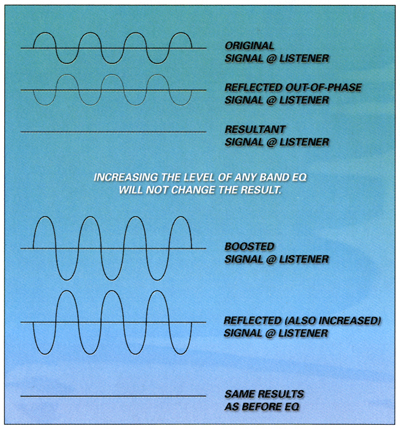|
Why can't you correct room acoustics with
electronics?
Use of sophisticated (and expensive)
equalization to attempt room correction made the
rounds of sound reinforcement companies and
recording studios in the sixties and seventies.
It’s now back (times five or more ) in home
theater rooms. While equalization can make a
good system sound even better in a good room, it
does not re-write the laws of physics.
The room is an active environment. It will fight
back in what we’ll call an acoustic “Zero Sum”
game: increasing the power of the absent
frequency also increases the level of the
out-of-phase room reflection, perpetuating the
“null” in the room.
It may even be possible broaden it. Remember if
the sum of the +3dB SPL original and –3 dB SPL
reflection equals zero, so too will adding 3 dB
for a + 6 dB original SPL and – 6 dB reflection
SPL sum to zero.
This can be demonstrated effectively with a
simple science experiment: Using a single driver
loudspeaker, a single frequency oscillator, and
an amplifier, feed a 1000 Hz tone to the speaker
through the amplifier to achieve a comfortable
listening level. Reposition the speaker to face
a hard, flat surface approximately 6-3/4 inches
away. The sound will all but disappear.
Click Here to see a video demonstration of this
experiment.
This is due to the distance being one half
wavelength of 1000 Hz. The reflected energy is
180 degrees out-of-phase with the source. The is
most easily shown graphically:

Increasing the source signal level will always
cause a corresponding increase in the reflected
signal level. In practice, the reflected signal
is going to be slightly less and some sound will
be heard as signal strength will diminish over
distance and absorption.
Footnote: Sound travels at approximately 1130
feet per second in air.
The wavelength of 1000 Hz is 1130 feet divided
by 1000 Hz equals 1.13 feet. Half wavelength is
1.13 feet, which divided by 2 times 12 inches
per foot equals 6.78 inches. This calculation
will vary slightly for temperature, pressure
(altitude) and humidity conditions.
Haven’t we passed this way before?
During the days of increasing playback channels
(mono, stereo, quad) and increasing recording
tracks (mono, two track, three track, four
track, eight track, twelve track, sixteen track,
twenty four track) there was also an increasing
awareness of acoustics. Why did the mix sound
different at home or in the car not to mention
in the next studio? The authors have seen rooms
vary 12 dB within the same facility with mixes
being all bass or no bass depending upon the
room in which they started.
When these rooms were corrected with
equalization, it typically covered only the
mixing engineer’s position or “sweet spot”. Some
complained of having to wear a neck brace for
fear of falling out of the sweet spot. Of
course, the producer, needing to hear the same
mix would literally be in the engineer’s lap,
and, if the artist and musicians came in to
listen, not only would they not hear the “real”
mix, they changed the acoustics of the room by
being there.
Adding or subtracting by equalizing induces
phase shift and “ringing” due to deteriorating
quality. The equalization curve is bell shaped.
Increasing “EQ” broadens the effect to the
nearby frequencies as well as the offending one,
creating a situation requiring further
correction. A narrow “high Q” equalizer may
overcome this but introduce its own problems
such as phase shift. An equalized boost or cut
doesn’t change the resonance of the room, it can
only “correct” an idealized sweet spot.
With the new range of room equalizers averaging
around $10,000 the serious audiophile is wise to
consider as little as one-third of that amount
to acoustically treat the room. A two-inch panel
of 7 pound per cubic foot fiberglass will
effectively eliminate reflections above 500 Hz
and also reduce the problems by 45 to 75 percent
in the two octaves below that point. It will
allow the “upscale” equalizer to do its job (or
possibly eliminate the need for it). The sweet
spot will be widened.
What is the ideal room?
We often read about the “ideal” room. Ideal
would seem to imply a unique right way of doing
something. However, there are several ideal
rooms.
“Ideal” Room Ratios (set up for equal ceiling
height)
|
Harmonic
Vern Knudsen
European
J. Volkmann
P. E. Satsine
Golden Section |
1: 2.00: 3.00
1: 1.88: 2.50
1: 1.67: 2.67
1: 1.60: 2.50
1: 1.50: 2.50
1: 1.62: 2.62 |
The harmonic is least desirable because of its
coincident reinforcement of normal room modes
resulting in a series of tones. To refute this,
all one has to do is enter the room to alter its
acoustic properties, add more furniture, etc.
Every room will have “modes”. The real design
criteria is to have “many” and spaced closely
together. The lowest natural room frequency is
typically the axial mode (length, or longest
dimension) and is determined by the following
formula:
(Frequency) f = c/2L = 1130/2L,
Where C = speed of sound (1130 feet per second
in air); L = room length
Conclusion: It is unfair to judge any piece of
audio gear in a room that fights back. Fixing a
room with an equalizer is only one of many audio
myths. Correct the acoustics first and all of
the equipment, including the equalizer, will
have a chance to live up to its published
potential.
Nick Colleran is a principal in Acoustics First
Corporation and a former president of the
Society of Professional Audio Recording Services
(SPARS).
John Gardner is an acoustical consultant who has
designed and built professional recording and
theatrical facilities throughout the world.
|